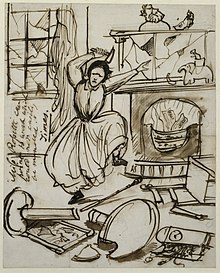탠트럼
TantrumA 칭얼대다혈질, 붕괴를 맞거나 심술은 감성적인 outburst,[1][2][3]보통과 관련된 그것들에 감정적인 괴로움, 일반적으로 특징에 의해 고집, 울고 소리 치며 violence,[4]defiance,[5]화가 나ranting, 저항에 시도 선뭈고, 어떤 경우 공격과 다른 신체적으로 폭력적. 행동.신체적 통제력이 상실될 수 있고, 그 사람은 가만히 있지 못할 수 있으며, 그 사람의 "목표"가 달성되더라도, 그들은 진정되지 않을 수 있다.짜증을 내는 것은 아이가 유치장에 가거나 더 나이 든 학생들에게 [6][7][8][9][10][11]정학 처분을 받게 할 수 있다.짜증은 장황한 [6][7][12]장황한 연설로 표현될 수 있다.
유아기에
짜증을 내는 것은 어린 아이들에게서 가장 흔한 형태의 문제 있는 행동 중 하나이지만,[13] 아이가 자라면서 빈도와 강도가 감소하는 경향이 있다.유아의 경우, 짜증을 정상으로 간주할 수 있으며,[14][15][16] 심지어 성격의 강도를 발달시키는 척도로도 간주할 수 있습니다.
때때로 짜증을 미래의 반사회적 [17]행동의 예측요인으로 보는 반면, 다른 의미에서는 그저 과도한 [18]좌절의 나이에 맞는 신호일 뿐이고,[19][20][21] 차분하고 일관된 대처가 이루어지면 시간이 지남에 따라 줄어들 것이다.아이가 표면적으로 요구하는 것이 아니라 자녀 자신을 억제할 수 없는 부모의 억제가 정말 필요한 [22]것일 수 있습니다.
Selma Fraiberg는 육아에서 "바지를 갈아입고, 보물찾고, 낮잠을 자고, 웅덩이를 헤치고, 쓰레기를 뿌리는 모든 경우를 정부의 위기로 바꾸면 우리는 쉽게 격렬한 반항, 짜증, 그리고 육아실에서의 폭죽을 일으킬 수 있다"고 경고했다.y"[23]를 클릭합니다.
지적 및 발달 장애
자폐증, 아스퍼거 증후군,[24][25] ADHD, 지적 장애와[26] 같은 발달 장애를 가진 몇몇 사람들은 비록 뇌 손상을 경험하는 사람은 누구나 [27]짜증을 겪을 수 있지만, 다른 사람들보다 짜증을 더 잘 낼 수 있습니다.남녀노소 [28][29]불문하고 누구나 가끔 짜증을 내기 쉽다.하지만, 감각 과부하로 인한 붕괴는 (신경적으로 전형적인 아이들도 겪을 수 있는) [30]성깔과 같지 않다.
이상
프로이트는 울프맨이 화를 내는 것이 그의 여동생에 의한 그의 유혹과 관련이 있다고 생각했다: 그는 "불만하고, 짜증을 내고, 폭력적이 되었고, 가능한 모든 경우에 화를 냈고,[31] 그리고 나서 화를 내며 야만인처럼 소리를 질렀다."프로이트는 그 짜증을 죄책감에[32] 의해 유발되는 처벌에 대한 무의식적인 욕구와 연결시켰다. 그는 그것이 어린 시절의 [33]짜증을 가진 많은 다른 사례들과 일반화될 수 있다고 생각했다.
하인즈 코후트는 성질이 유아들의 거창하고 과시적인 핵심이 좌절되면서 생기는 자아도취적인 [34]분노라고 주장했다.부풀려진 자아상에 대한 타격은, 아이의 소망이 (아무리 정당해도) 거절당했을 때, 만능의 느낌을 공격하기 때문에 분노를 [35]일으킨다.
형제자매의 탄생에 대한 질투와 그에 따른 공격성은 감정을 조절하려는 노력이 아이의 자기 [36][37]조절 시스템을 과부하로 만들기 때문에 부정적인 성질을 유발할 수도 있습니다.
만년에
작가 윌리엄 메이크피스 새커레이는 만년에 "그 얼굴의 고통스럽고 불만스러운 표정으로 볼 수 있는 한 화를 낼 수 있다"고 주장했다."그렇게 표현해도 되겠다면,[38]
하인즈 코후트는 "아기의 중심에는 자기중심적이고 거창한 과시주의 부분이 있을 것 같다"며 "좌절을 느끼는 경향은 부풀려진 자아상에 대한 타격에 대해 자아도취적 [34]분노를 나타낸다"고 주장했다."어린이는 어떤 거절에 직면하게 되는데... 이유가 무엇이든 간에, 거절은 그의 전지전능감을 불쾌하게 하기 때문에 자동적으로 분노를 불러일으킨다."[35]
연예인이 최소한으로[39] 좌절될 때마다 성질을 부리는 것은 일종의 후천적인 상황적[40] 자아도취 또는 성질을 부리는 행동이다.
만약 노인들이 성질을 보인다면, 그들은 종종 미성숙하거나 정신 장애의 징후일 수 있다; 그리고 종종 자폐증이나 ADHD 용해는 성질을 내는 것으로 잘못 표기된다.그것은 또한 극심한 스트레스를 받는 전형적인 신경계 사람들에게도 발생할 수 있다.[41]
「 」를 참조해 주세요.
레퍼런스
- ^ Album, Cabinet (1830). "The Cabinet Album A Collection of Original and Selected Literature". The. Hurst, Chance and Company: 92.
- ^ Foote, Samuel (1765). "The Dramatic Works Volume 1". The Dramatic works. P. Vaillant. 1: 40–41.
- ^ Payn, James (1869). Married Beneath Him. A novel. By the author of “Lost Sir Massingberd” James Payn. The British Library. p. 369.
- ^ O'Hara, Kane (1770). "Midas An English Burletta. As it is Performed at the Theatre-Royal, in Covent-Garden". Midas An English Burletta. As it is Performed at the Theatre-Royal, in Covent-Garden: 20.
- ^ GOMBERT, A. J. (1825). "The French Drama ... with Notes Critical and Explanatory, by A. G. Volume 2 of The French Drama ... with Notes Critical and Explanatory, by A. G". The French Drama... The British Library. 2: 47.
- ^ a b Penelope Leach. "What is a tantrum?". BabyCentre. Retrieved 2011-03-20.
- ^ a b "Temper Tantrums". KidsHealth. Retrieved 2011-03-20.
- ^ Karisa Ding (July 26, 2017). "Tantrums". BabyCenter. Retrieved 2011-03-20.
- ^ Jan Hunt. "When a Child Has a Tantrum". The Natural Child Project. Retrieved 2011-03-20.
- ^ Mullen, J.K. (1983). "Understanding and managing the temper tantrum". Child Care Quarterly. 12 (1): 59–70. doi:10.1007/BF01258080. S2CID 144110786.
- ^ Geelerd, E.R. (1945). "Observations on temper tantrums in children". American Journal of Orthopsychiatry. 15 (2): 238–246. doi:10.1111/j.1939-0025.1945.tb04937.x.
- ^ Daniels, Elizabeth; Mandleco, Barbara; Luthy, Karlen E. (2012). "Assessment, management, and prevention of childhood temper tantrums". Journal of the American Academy of Nurse Practitioners. 24 (10): 569–573. doi:10.1111/j.1745-7599.2012.00755.x. PMID 23006014.
- ^ Banham Bridges, Katharine M. (1932). "Emotional Development in Early Infancy". Child Development. 3 (4): 324–341. doi:10.1111/j.1467-8624.1932.tb05842.x. JSTOR 1125359.
- ^ Robin Skynner; John Cleese (1993). Families and how to survive them. p. 177.
- ^ Isaacs, S. (1940). "Temper tantrums in early childhood in their relation to internal objects". The International Journal of Psychoanalysis. 21: 280–293.
- ^ Solter, A. (1992). "Understanding Tears and Tantrums". Young Children. 47 (4): 64–68. JSTOR 42725308.
- ^ Potegal, Michael; Davidson, Richard J. (June 2003). "Temper Tantrums in Young Children". Journal of Developmental & Behavioral Pediatrics. 24 (3): 140–147. doi:10.1097/00004703-200306000-00002. PMID 12806225. S2CID 23682833.
- ^ Green, J.A.; Whitney, P.G.; Potegal, M. (2011). "Screaming, yelling, whining, and crying: Categorical and intensity differences in vocal expressions of anger and sadness in children's tantrums". Emotion. 11 (5): 1124–1133. doi:10.1037/a0024173. PMC 3192404. PMID 21707157.
- ^ Roy Benaroch (2008). Solving Health and Behavioral Problems from Birth Through Preschool. p. 157.
- ^ Kopp, C.B. (1989). "Regulation of distress and negative emotions: A developmental view". Developmental Psychology. 25 (3): 343–354. doi:10.1037/0012-1649.25.3.343.
- ^ Levine, Linda (1995). "Young Children's Understanding of the Causes of Anger and Sadness". Child Development. 66 (3): 967–709. doi:10.2307/1131944. JSTOR 1131944.
- ^ Patrick Casement (1990). Further Learning from the Patient. p. 113–4.
- ^ Selma H. Fraiberg (1987). The Magic Years. p. 65.
- ^ Margolies, P.J. (1977). "Behavioral approaches to the treatment of early infantile autism: A review". Psychological Bulletin. 84 (2): 249–264. doi:10.1037/0033-2909.84.2.249. PMID 840962.
- ^ Lord, C. (1993). "Early Social Development in Autism". In Edsopler, E.; Bourgondien, M. Van; Bristol, M. (eds.). Preschool Issues in Autism. New York: Plenum Press. pp. 61–94.
- ^ Luiselli, J.; Murbach, L. (2002). "Providing Instruction from Novel Staff as an Antecedent Intervention for Child Tantrum Behavior in a Public School Classroom". Education and Treatment of Children. 25 (3): 356–365. JSTOR 42899711.
- ^ Lancioni, G. E.; Smeets, P. M.; Ceccarani, P. S.; Capodaglio, L.; Campanari, G. (1984). "Effects of gross motor activities on the severe self-injurious tantrums of multihandicapped individuals". Applied Research in Mental Retardation. 5 (4): 471–482. doi:10.1016/S0270-3092(84)80039-9. PMID 6240965.
- ^ Sandra Ketcham. "Temper Tantrums and Autism". LoveToKnow. Retrieved 25 March 2018.
- ^ Osterman, Karin; Bjorkqvist, Kaj (April 1, 2010). "A Cross-Sectional Study of Onset, Cessation, Frequency, and Duration of Children's Temper Tantrums in a Nonclinical Sample". Psychological Reports. 106 (2): 448–454. doi:10.2466/pr0.106.2.448-454. PMID 20524545. S2CID 43291154.
- ^ Bennie, Maureen (2 February 2016). "Tantrum vs Autistic Meltdown: What Is The Difference?". Autism Awareness. Autism Awareness Centre Inc. Retrieved 9 June 2017.
- ^ Sigmund Freud. Case Histories II (PFL 9). p. 242.
- ^ Sigmund Freud. Case Histories II (PFL 9). p. 257.
- ^ Sigmund Freud. Case Histories II (PFL 9). pp. 242 & 257–8.
- ^ a b H. Goldenberg; I. Goldenberg (2007). Family Therapy. p. 172.
- ^ a b J. Halliday/P.의 에드먼드 버글러입니다.풀러 엣지,도박의 심리학 (런던 1974년) 페이지 182
- ^ Selma H. Fraiberg (1987). The Magic Years. p. 152.
- ^ Dennis, Tracy A. (2006). "Emotional self-regulation in preschoolers: The interplay approach reactivity, and control capacities". Developmental Psychology. 42 (1): 84–97. doi:10.1037/0012-1649.42.1.84. PMID 16420120. S2CID 14692506.
- ^ William Makepeace Thackeray (1848). The Irish Sketch Book. p. 138.
- ^ Cooper Lawrence, Cult of Ce
- ^ Simon Crompton, All About Me (런던 2007) 페이지 176
- ^ "North Jersey". North Jersey. Retrieved 25 March 2018.
외부 링크
 Wiktionary에서 tantrum의 사전적 정의
Wiktionary에서 tantrum의 사전적 정의




